
Master Gothic Writing: Techniques for Crafting Dark Narratives
Share
Overview
Gothic writing? It’s a realm where atmospheric settings, supernatural elements, and psychological depth collide to forge dark narratives that linger in the shadows. Master it by wielding techniques that:
- Build suspense
- Paint vivid imagery
- Refine your prose
Each element pulls readers into immersive experiences, echoing the seductive allure of gothic literature. Ready to dive deeper?
Introduction
In the realm of literature, few genres spark as much intrigue as gothic writing. With roots steeped in the exploration of human emotion, the supernatural, and the sublime, gothic narratives whisk readers away to haunting landscapes where beauty dances with horror. From the chilling tales of Edgar Allan Poe to the groundbreaking works of Mary Shelley, this genre relentlessly challenges perceptions and illuminates the shadowy corners of the human psyche.
As contemporary storytelling embraces a renaissance of gothic elements, the allure of atmospheric settings, complex characters, and profound psychological themes remains potent. This article plunges into the essence of gothic writing, unveiling its key components and offering techniques for crafting compelling narratives that resonate deeply with audiences.
It highlights how Darc Arts embodies this unique aesthetic through its premium offerings. Are you ready to explore the depths of this captivating genre?
Understand the Essence of Gothic Writing
Gothic writing explores the depths of human experience, frequently featuring haunting landscapes and eerie backdrops. Born in the 18th century, gothic writing emerged as a fierce counter to the cold reason of the Enlightenment. Gothic writing thrives on themes of raw emotion, the supernatural, and the sublime—each evoking a spine-tingling sense of fear and mystery.
Think of iconic writers like Edgar Allan Poe and Mary Shelley, who are known for their gothic writing that compels readers to confront both beauty and horror. Poe once whispered, 'There is no exquisite beauty… without some strangeness in the proportion,' a haunting reflection of dark literature that resonates with Darc Arts' philosophy of fusing beauty with life's shadowy elements.
The term 'Gothic' surged in popularity in 1858, reflecting a growing obsession with the macabre, themes that pulse at the heart of gothic writing in the Darc Arts experience. Today, gothic writing's influence seeps into contemporary narratives, with a revival of interest in its distinctive aesthetic.
Key traits? Gothic writing features psychological depth, atmospheric settings, and complex characters, all daring readers to explore the shadows of the human psyche. At Darc Arts, we elevate this exploration with premium THCA products, like our infused prerolls and sophisticated flower selections, each crafted to embody elegance.
Customer testimonials reveal how our products amplify their experiences, intertwining the macabre with the beautiful. Through historical case studies and expert analysis, one can grasp how dark literature, including gothic writing, has shaped modern storytelling, weaving a rich tapestry that mirrors the hauntingly powerful cannabis experiences we offer.

Explore Key Elements of Gothic Narratives
Dive into the Dark Allure of Gothic Narratives
- Atmospheric Settings: Picture dark, decaying castles and eerie forests, abandoned mansions that whisper secrets of the past. These backdrops don’t just set the stage; they breathe life into a sense of foreboding and mystery. They mirror the inner turmoil of characters, intensifying the tension and drawing readers into a world where elegance collides with darkness.
- Supernatural Elements: Ghosts, apparitions, and otherworldly beings twist our grip on reality, blurring the boundaries of the known and the unknown. As Horace Walpole noted, 'The damsel’s persona is often confined in a castle, terrorized by a nobleman, and rendered powerless.' This isn’t just intrigue; it’s a reflection of our deepest psychological struggles, echoing the themes that haunt dark literature, especially evident in gothic writing, where complex characters like morally ambiguous protagonists and enigmatic villains reign supreme. Take Charlotte Brontë's 'Jane Eyre,' where the hidden complexities of Mr. Rochester propel the plot. This dynamic interplay beckons us to explore the shadowy corners of human nature, enhancing the themes present in gothic writing. This exploration of vulnerability enriches the narrative, allowing readers to connect with the internal conflicts of individuals. The loneliness depicted often mirrors societal limitations and personal battles, crafting a hauntingly relatable experience.
- Symbolism: Darkness, decay, and the supernatural pulse with deeper meanings, evoking visceral emotional responses. The decaying castle? A symbol of noble ideals crumbling. The supernatural? A manifestation of unresolved traumas. Edgar Allan Poe’s 'The Black Cat' showcases how these symbols amplify the emotional resonance of the story, highlighting the importance of gothic writing in enhancing narrative depth. Craft a rich tapestry that captivates and unsettles, drawing your audience into a realm where the gothic aesthetic reigns supreme.
Apply Techniques for Crafting Dark Narratives
To craft compelling dark narratives, embrace these techniques:
- Build Suspense Gradually: Master pacing to create tension, letting fear simmer just beneath the surface. This slow burn keeps readers on edge, heightening their emotional investment in the story.
- Employ Vivid Imagery: In gothic writing, descriptive language is essential. Paint haunting scenes that engage the senses—imagine the 'cold, damp air' wrapping around figures or the 'creaking of ancient floorboards' echoing through a desolate hall. Such imagery captivates and immerses individuals in the atmosphere.
- Create Unreliable Narrators: Introduce characters with distorted perceptions, leaving audiences questioning the truth. This technique adds layers of complexity and intrigue, urging individuals to delve deeper into the narrative.
- Incorporate Foreshadowing: Weave subtle hints about future events throughout the narrative. This fosters a sense of inevitability and dread, drawing readers into the unfolding mystery.
- Utilize Dialogue: Craft conversations that reveal character motivations and deepen the mystery. Fragmented speech can indicate tension or fear, elevating the emotional stakes of the story.
These methods are crucial for crafting captivating tales in gothic writing that immerse individuals in the ambiance, allowing them to feel the thrill of suspense and the allure of vivid imagery. In 2024, horror, dark academia, and feminist horror reign as leading dark-themed genres, reflecting a growing fascination with these narratives. Dion asserts, "the story is iconic for a reason, the emotion and depth of characters is second to none," underscoring character depth's role in engaging readers. Moreover, the case study "Join the Darc Side" showcases how Darc Arts embodies a movement harmonizing dark elegance and cannabis wellness, inviting consumers to embrace a lifestyle steeped in mystery and sophistication. By weaving these elements together, writers can create stories that resonate deeply with their audience.

Refine and Polish Your Gothic Prose
To refine and polish your gothic prose, consider these techniques:
- Read Aloud: Let your words echo in the air. Hearing them can expose awkward phrasing and elevate the flow of your narrative. Studies, like those by Brooks, reveal that reading aloud not only enhances writing quality but also deepens your connection to the text, sharpening your language skills.
- Seek Feedback: Share your dark creations with trusted peers or writing groups. Fresh perspectives and constructive criticism can ignite your writing. Engaging with others fosters a sense of community, much like the movement Darc Arts nurtures among those enchanted by elegant darkness. As Keith Kekic provocatively states, "Walk with this tomorrow night. If nothing happens, then don’t come back," underscoring the importance of exploration and feedback in your creative journey.
- Focus on Word Choice: Choose words that conjure the desired mood. Opt for 'gloomy' over 'sad' or 'haunting' instead of 'creepy' to amplify that dark tone. The right word can morph a mundane sentence into a vivid image.
- Eliminate Redundancies: Cut out unnecessary words or phrases that fail to contribute to the atmosphere or plot. This streamlining is vital for preserving the intensity and clarity of your story.
- Edit for Consistency: Keep your narrative voice and style uniform throughout, maintaining that dark aesthetic. A cohesive style pulls the audience deeper into your world.
Devote time to refine your prose, and you'll elevate your writing, crafting a more immersive experience for your readers. Invite them into the enchanting, mysterious realms of gothic writing. The sense of belonging and exploration fostered by Darc Arts can inspire you to embrace your unique voice and narrative style.
Conclusion
Gothic writing remains a genre that pulls readers into haunting landscapes, where beauty dances with horror and the depths of human emotion are laid bare. This article uncovers the key elements that define this captivating style:
- Atmospheric settings
- Supernatural elements
- Complex characters
- Themes of isolation and madness
These components not only enrich the gothic narrative but also dare readers to confront the darker corners of the human psyche.
Crafting compelling gothic tales demands various techniques—building suspense, wielding vivid imagery, and conjuring unreliable narrators. These strategies amplify emotional engagement, immersing the audience in the eerie, mysterious world that gothic literature embodies. And let’s not forget the art of refining prose; feedback, precise word choice, and a consistent style elevate the narrative to haunting heights.
Ultimately, the resurgence of gothic themes in contemporary storytelling, as showcased by the offerings of Darc Arts, underscores the genre's timeless allure. By embracing the gothic aesthetic and its profound psychological themes, writers can weave narratives that resonate deeply, drawing audiences into a realm where elegance meets darkness. This exploration not only celebrates the rich history of gothic literature but also paves the way for innovative storytelling that continues to captivate and inspire.
Frequently Asked Questions
What is gothic writing?
Gothic writing explores the depths of human experience, often featuring haunting landscapes and eerie backdrops. It emerged in the 18th century as a counter to the Enlightenment's cold reason, focusing on themes of raw emotion, the supernatural, and the sublime.
Who are some iconic writers associated with gothic writing?
Iconic writers of gothic writing include Edgar Allan Poe and Mary Shelley, known for their works that compel readers to confront both beauty and horror.
What themes are prevalent in gothic writing?
Prevalent themes in gothic writing include raw emotion, the supernatural, and the sublime, all of which evoke a sense of fear and mystery.
When did the term 'Gothic' become popular, and what does it reflect?
The term 'Gothic' surged in popularity in 1858, reflecting a growing obsession with macabre themes that are central to gothic writing.
How does gothic writing influence contemporary narratives?
Gothic writing's influence seeps into contemporary narratives, with a revival of interest in its distinctive aesthetic.
What are key traits of gothic writing?
Key traits of gothic writing include psychological depth, atmospheric settings, and complex characters, inviting readers to explore the shadows of the human psyche.
How does Darc Arts relate to gothic writing?
At Darc Arts, gothic writing is elevated through premium THCA products, such as infused prerolls and sophisticated flower selections, which embody elegance and enhance the exploration of beauty and darkness.
What do customer testimonials reveal about Darc Arts products?
Customer testimonials reveal that Darc Arts products amplify experiences by intertwining the macabre with the beautiful.
How has gothic writing shaped modern storytelling?
Gothic writing has shaped modern storytelling through historical case studies and expert analysis, weaving a rich tapestry that mirrors powerful cannabis experiences offered by Darc Arts.
